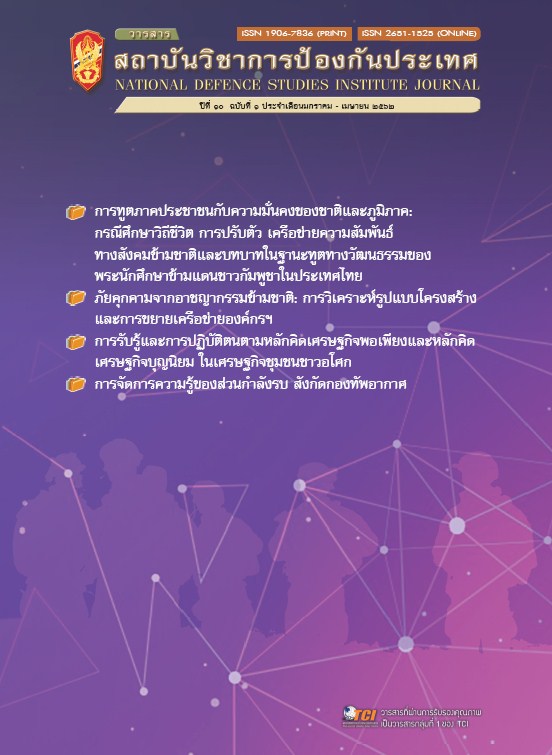The Perception, Attitude, and Guideline of the Cadets of Chulachomklao Royal Military Academy Toward Thailand 4.0
Main Article Content
Abstract
The objectives of this research were
1) to study perception and attitude of cadets towards Thailand 4.0 and 2) to study Guideline of cadets toward Thailand 4.0. Sample sizes were304 cadets from Chulachomklao Royal Military Academy. This research was a quantitative research design. There were 304 cadets in the 1st - 5th year. The research instrument used a questionnaire to collect data. Statistics used in data analysis were frequency, percentage, mean, standard deviation, one-way analysis of variance, and Pearson's simple correlation coefficient.
The results showed the following:
1) The findings on the perceptions and attitudes of cadets towards the Thailand 4.0concept found that: In terms of perceptions, between perception through individuals and through mass media, both are at a high level. Perception through individuals found that the perception through the instructor was at the highest level. Perception through mass media found that the perception through YouTubeand Facebook was the highest. In terms of attitudes, between cognitive attitudes and affective attitudes, both are at a high level. Cognitive attitudes have the highest level of belief in the concept of Thailand 4.0 can create a balance of economic and social stability, wealth and sustainability. The cadets perceived and had an attitude towards the concept of Thailand 4.0 at a high level. In terms of perception, cadets have the highest level of awareness across YouTube and Facebook. In terms of attitudes, the cadets believed that the concept of Thailand 4.0 could create an economic and social balance, therefore, yield to national stability, prosperity and sustainability. Affective attitudes have the highest level of feeling that Chulachomklao Royal Military Academy should provide learning about the concept of Thailand 4.0. In addition, it was found that the perception of information was correlated with the attitudes of the cadets at the 0.01 level of statistical significance.
2) The findings on the guideline of cadets towards the Thai 4.0 concept found that: The first approach on Enhancing Innovation-Energy conservation awareness should be used. The second approach on Creating a Society with Spiritual Entrepreneurship-Strengthen military leadership skills through institutional training through appointment to active duty and self-development should be used. The third approach on Strengthening the Community and Networks--. Strengthening joint military ideology should be used. The fourth approach on Linking with the World Community--Development of social intelligence, Understanding different cultures, Technology Capabilities, Innovative ideas, Communication skills and Global Environmental Awareness should be used.
Article Details
The articles, images, tables, graphs, written content, and opinions published in this journal are solely those of the authors and do not necessarily reflect the views or positions of the National Defence Studies Institute or its academic affiliates.
References
กรมยุทธการทหาร กองบัญชาการกองทัพไทย. (๒๕๖๑). นโยบายผู้บัญชาการทหารสูงสุด ประจำปีงบประมาณ ๒๕๖๑.
กรุงเทพฯ: หจก.อรุณการพิมพ์.
กรมยุทธศึกษาทหารบก. (๒๕๕๖). คู่มือนายทหารสัญญาบัตร ประจ ำปี ๒๕๕๖. กรุงเทพฯ: อรุณการพิมพ์.
กองทัพบก. (๒๕๑๗). คู่มือราชการสนาม ว่าด้วยลักษณะผู้นำทางทหาร (รส. ๒๒-๑๐๐). กรุงเทพฯ.
กองบริหารงานวิจัยและประกันคุณภาพการศึกษา. (๒๕๕๙). พิมพ์เขียว Thailand 4.0 โมเดลขับเคลื่อนประเทศไทย
สู่ความมั่นคง มั่งคั่ง และยั่งยืน. กรุงเทพฯ: กองบริหารงานวิจัยและประกันคุณภาพการศึกษา.
กองวิชาความมั่นคงและวิชาพิเศษ. (๒๕๕๒). เอกสารประกอบวิชาคุณธรรมและจริยธรรมกองวิชาความมั่นคงและวิชาพิเศษ.
ฝ่ายวิชาการ กรมยุทธศึกษาทหารเรือ.
เกียรติศักดิ์ แสงอรุณ. (๒๕๕๑). แนวทางการพัฒนาจิตสำนึกสาธารณะสำหรับเยาวชนไทย: กรณีศึกษากลุ่มและเครือข่าย
เยาวชนที่ทำงานด้านจิตสำนึกสาธารณะ. จุฬาลงกรณ์มหาวิทยาลัย.
จักราวุธ คงอินทร์ และคณะ. (๒๕๖๐). พฤติกรรมการใช้เครือข่ายสังคมออนไลน์ของนักเรียนนายร้อย(รายงานวิจัย).
นครนายก.
ชิดชนกทองไทย. (๒๕๕๖). การรับรู้ และทัศนคติ ที่มีผลต่อความพร้อมในการเข้าสู่ตลาดแรงงานประชาคมอาเซียน
ของนักศึกษาปริญญาโท มหาวิทยาลัยศรีนครินทรวิโรฒ (ปริญญาบริหารธุรกิจมหาบัณฑิต). มหาวิทยาลัย
ศรีนครินทรวิโรฒ. กรุงเทพฯ.
เดวิท แมทิวส์. (๒๕๔๐). จากปัจเจกสู่สาธารณะกระบวนการเสริมสร้างชุมชนให้เข้มแข็ง(ฐิรวุฒิ เสนาคำ, ผู้แปล)กรุงเทพฯ:
สถาบันชุมชนท้องถิ่นพัฒนา.
ประเวศ วะสี. (๒๕๔๑). ชุมชนเข้มแข็งทุนทางสังคมไทย. กรุงเทพฯ: สำนักงานกองทุนเพื่อสังคมและธนาคารออมสิน.
พรพรรษ์ ภู่กฤษณา. (๒๕๕๕). แนวทางการจัดกิจกรรมการเรียนรู้เพื่อเสริมสร้างจิตสำนึกการอนุรักษ์ธรรมชาติของชุมชน
บริเวณอุทยานแห่งชาติทางทะเล (วิทยานิพนธ์ครุศาสตรมหาบัณฑิต สาขาการศึกษานอกระบบโรงเรียน).
จุฬาลงกรณ์มหาวิทยาลัย.
พิชัย นริพทะพันธุ์. (๒๕๕๙, ๒๗ เมษายน). ปรับเปลี่ยนประเทศไทย (ไทยแลนด์ ๔.๐)มติชนรายวัน.
ภักดี รัตนมุขย์. (๒๕๖๑). Thailand 4.0 ตอบโจทย์ประเทศไทย?. กรุงเทพฯ: สำนักพิมพ์ปัญญาชน.
โรงเรียนนายร้อยพระจุลจอมเกล้า. (๒๕๕๔). เอกสารประกอบการบรรยายสรุปการเสริมสร้างอุดมการณ์ทหาร.
วชิราภรณ์สุรธนะสกุล. (๒๕๕๗). การนำเสนอรูปแบบการเสริมสร้างความเข้มแข็งของชุมชนโดยวิทยาลัยชุมชน(วิทยชุมชนานิพธ์ ปริญญาครุศาสตรดุษฎีบัณฑิต สาขาวิชาอุดมศึกษา). จุฬาลงกรณ์มหาวิทยาลัย.
วรรณิภา สันป่าแก้ว. (๒๕๕๖). แนวทางการเสริมสร้างจิตสำนึกด้านการอนุรักษ์พลังงานของเยาวชน(วิทยานิพนธ์ปริญญา
ครุศาสตรมหาบัณฑิต สาขาวิชาพัฒนศึกษา). จุฬาลงกรณ์มหาวิทยาลัย.
วรรณี ชลนภาสถิต. (๒๕๕๒). SMEs ธุรกิจกู้เศรษฐกิจ. เศรษฐศาสตร์และบริหารธุรกิจปริทัศน์ มหาวิทยาลัยรังสิต,๕(๑),
๕-๑๙.
ราชกิจจานุเบกษา. (๒๕๕๑). พระราชบัญญัติจัดระเบียบราชการกระทรวงกลาโหม พ.ศ. ๒๕๕๑.
ศูนย์ศึกษายุทธศาสตร์ สถาบันวิชาการป้องกันประเทศ. (๒๕๖๑). แนวทางการพัฒนากองทัพไทยเพื่อรองรับนโยบาย
ไทยแลนด์ ๔.๐ ใน การประชุมวิชาการศูนย์ศึกษายุทธศาสตร์ครั้งที่ ๑/๒๕๖๑.
สมพงษ์ สิงหพล. (๒๕๔๒). ต้องสอนให้เกิดจิตสำนึกใหม่. สีมาจารย์, ๑๓(๒๗), ๑๕-๑๖.
สำนักงานพัฒนาธุรกรรมทางอิเล็กทรอนิกส์(องค์การมหาชน). (๒๕๖๐). รายงานผลการส ำรวจพฤติกรรมผู้ใช้อินเทอร์เน็ต
ในประเทศไทยปี ๒๕๖๐. กรุงเทพฯ: สำนักงานพัฒนาธุรกรรมทางอิเล็กทรอนิกส์ กระทรวงดิจิทัลเพื่อเศรษฐกิจ
และสังคม.
สำนักวิจัยและพัฒนาระบบงานบุคคล. (๒๕๖๐). ประเทศไทยในบริบทไทยแลนด์ ๔.๐ ภายใต้รัฐธรรมนูญแห่งราชอาณาจักรไทย พุทธศักราช ๒๕๖๐. กรุงเทพฯ: สำนักวิจัยและพัฒนาระบบงานบุคคล.
สุธีรา อะทะวงษา. (๒๕๕๖). คุณลักษณะของการเป็นผู้ประกอบการและลักษณะของสถานประกอบการที่มีผลต่อ
การเจริญเติบโตของวิสาหกิจขนาดกลางและขนาดย่อมของประเทศไทย(วิทยานิพนธ์บริหารธุรกิจดุษฎีบัณฑิต).
มหาวิทยาลัยธุรกิจบัณฑิตย์.
สุพจน์ทรายแก้ว. (๒๕๔๖). จิตสำนึกสาธารณะ: การก่อรูปและกระบวนการเสริมสร้าง. กรุงเทพฯ:วารสารเพชรบุรีพิทยา
ลงกรณ์.
สุวิทย์ เมษินทรีย์. (๒๕๕๙). ประเทศไทย ๔.๐ โมเดลขับเคลื่อนสู่ความมั่งคั่งนคงและยั่งยืนใน การบรรยายพิเศษ.
กรุงเทพฯ.
สุวิทย์ เมษินทรีย์. (๒๕๖๐). การบริหารการศึกษาเพื่อร่วมสร้างประเทศไทย ๔.๐. กรุงเทพฯ: ห้างหุ้นส่วนจำกัด โรงพิมพ์
วัชรินทร์ พี.พี.
เสถียร เชยประทับ. (๒๕๒๕). การสื่อสารงานนวัตกรรม. กรุงเทพฯ: คณะนิเทศศาสตร์ จุฬาลงกรณ์มหาวิทยาลัย.
เสาวภาคย์ แหลมเพ็ชร.( ๒๕๕๙). พฤติกรรมและผลกระทบจากการใช้เครือข่ายสังคมออนไลน์ของนักเรียนระดับชั้น
มัธยมศึกษาตอนปลายในจังหวัดนนทบุรี. สุทธิปริทัศน์, ๙๓, ๑๑๙.
อารีย์วรรณ สุทธิพงศ์พันธ์. (๒๕๖๐.). กลยุทธ์การบริหารวิชาการโรงเรียนนายร้อยพระจุลจอมเกล้าตามแนวคิดคุณลักษณะ
ความเป็นผู้นำทางทหารและความมั่นคงของชาติในศตวรรษที่ ๒๑ (วิทยานิพนธ์ดุษฎีบัณฑิต สาขาบริหารการศึกษา
ภาควิชานโยบาย การจัดการและความเป็นผู้นำทางการศึกษา). จุฬาลงกรณ์มหาวิทยาลัย.
Assael, H. (2004). Consumer Behavior: A Strategic Approach. MA: Houghton Mifflin Company.
Brown, B. R. (2016). Mission Command in the 21st Century: Empowering to Win in a Complex World
Fort Leavenworth, Kansas: The Army press.
Farthing, G. E. (1992). The psychology of consciousness. Englewood cliffs, NJ: Prentice Hall.
Freire, P. (1973). Education for critical consciousness. London: Sheed and Ward.
Eiser, J. R. (Eiser). Social psychology: attitudes cognition and social behavior. New York: The Press
Syndicate of the University of Cambridge.
Headquarters. (2011). FM 7-0: Training Units and Developing Leaders for Full Spectrum Operations.
Washington D.C.: Department of the Army.
Hodgetts, R. M., & Kuratko, D. F. (1955). Effective Small Business Management (5th ed.). Fort Worth: Dryden.
Kihlstrom, J. F. (1984). Conscious, subconscious, unconscious: A cognitive perspective. New York:
John Wiley & Sons.
Likert, R. A. (1932). Technique for the Measurement of Attitudes. Archives of Psychology, 22.
Najafipour, F. (2016). Commanders of the 21st Century: Different Skills of Today Commanders.
Journal of Archives in Military Medicine, 4(2). doi:10.5812/jamm.38945
Schiffman, L. G., & Kanuk, L. L. (2010). Consumer behavior. NJ: Pearson Prentice Hall.
Yamane, T. (1973). Statistics: an introductory analysis. New York: Harper & Row.


